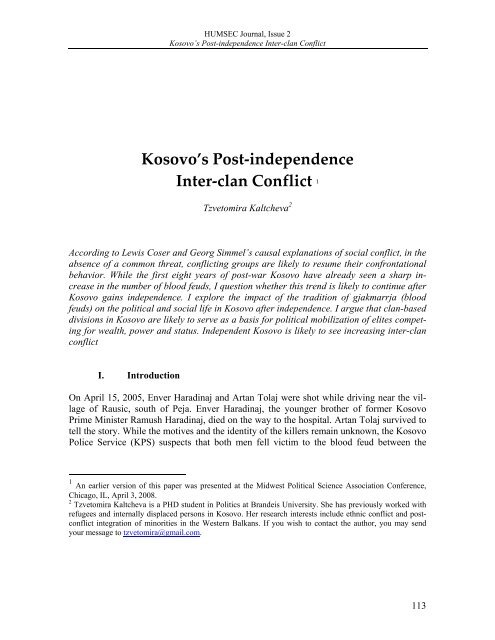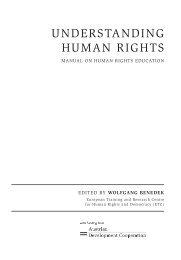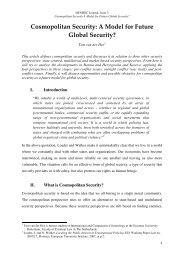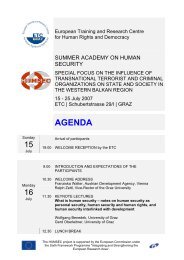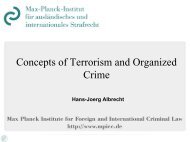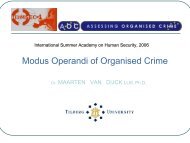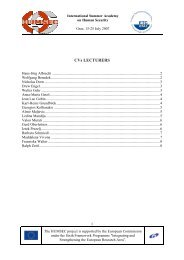Kosovo's Post-independence Inter-clan Conflict - HUMSEC
Kosovo's Post-independence Inter-clan Conflict - HUMSEC
Kosovo's Post-independence Inter-clan Conflict - HUMSEC
Create successful ePaper yourself
Turn your PDF publications into a flip-book with our unique Google optimized e-Paper software.
<strong>HUMSEC</strong> Journal, Issue 2<br />
Kosovo’s <strong>Post</strong>-<strong>independence</strong> <strong>Inter</strong>-<strong>clan</strong> <strong>Conflict</strong><br />
Kosovo’s <strong>Post</strong>‐<strong>independence</strong><br />
<strong>Inter</strong>‐<strong>clan</strong> <strong>Conflict</strong> 1<br />
Tzvetomira Kaltcheva 2<br />
According to Lewis Coser and Georg Simmel’s causal explanations of social conflict, in the<br />
absence of a common threat, conflicting groups are likely to resume their confrontational<br />
behavior. While the first eight years of post-war Kosovo have already seen a sharp increase<br />
in the number of blood feuds, I question whether this trend is likely to continue after<br />
Kosovo gains <strong>independence</strong>. I explore the impact of the tradition of gjakmarrja (blood<br />
feuds) on the political and social life in Kosovo after <strong>independence</strong>. I argue that <strong>clan</strong>-based<br />
divisions in Kosovo are likely to serve as a basis for political mobilization of elites competing<br />
for wealth, power and status. Independent Kosovo is likely to see increasing inter-<strong>clan</strong><br />
conflict<br />
I. Introduction<br />
On April 15, 2005, Enver Haradinaj and Artan Tolaj were shot while driving near the village<br />
of Rausic, south of Peja. Enver Haradinaj, the younger brother of former Kosovo<br />
Prime Minister Ramush Haradinaj, died on the way to the hospital. Artan Tolaj survived to<br />
tell the story. While the motives and the identity of the killers remain unknown, the Kosovo<br />
Police Service (KPS) suspects that both men fell victim to the blood feud between the<br />
1<br />
An earlier version of this paper was presented at the Midwest Political Science Association Conference,<br />
Chicago, IL, April 3, 2008.<br />
2<br />
Tzvetomira Kaltcheva is a PHD student in Politics at Brandeis University. She has previously worked with<br />
refugees and internally displaced persons in Kosovo. Her research interests include ethnic conflict and postconflict<br />
integration of minorities in the Western Balkans. If you wish to contact the author, you may send<br />
your message to tzvetomira@gmail.com.<br />
113
<strong>HUMSEC</strong> Journal, Issue 2<br />
Kosovo’s <strong>Post</strong>-<strong>independence</strong> <strong>Inter</strong>-<strong>clan</strong> <strong>Conflict</strong><br />
Musaj and the Haradinaj families. 3 If this is indeed true, why are such blood feuds taking<br />
place in Kosovo? How and why are blood feuds likely to influence the Kosovo political<br />
arena after <strong>independence</strong>?<br />
In this essay, I explore the impact of the tradition of gjakmarrja (“blood feuds”) on the political<br />
and social life in Kosovo after <strong>independence</strong>. I argue that <strong>clan</strong>-based divisions in<br />
Kosovo are likely to serve as a basis for political mobilization of elites competing for<br />
wealth, power and status. I will first provide a short description of the Kanun i Leke Dukagjinit<br />
(Code of Leke Dukadjini), which established the practice of blood feuds. Second, I<br />
will provide a theoretical analysis of the inter-<strong>clan</strong> relations. Finally, I will advance several<br />
hypotheses about the possible implications of the <strong>clan</strong>-based divisions on independent Kosovo.<br />
II. Blood Feuds And The Code Of Dukagjini<br />
What is a blood feud? Anthropological studies have detailed blood feuds among the Northern<br />
Albanian Ghegs, a practice that is likely to have spread to neighboring Kosovo and Macedonia<br />
in the early 20 th century. 4 The work of the British anthropologist Edith Durham<br />
(1863-1944) provides a particularly rich narrative on the traditions of the Ghegs and their<br />
adherence to the Code of Leke Dukagjini. 5 The Code is a customary law observed by the<br />
Ghegs as early as the 15 th century but formally recorded by Franciscan Father Shtjefėn<br />
Gjegjovi (1874-1929) in the mid-1920s.<br />
According to the Code, the principle of “an eye for an eye, a life for a life” defines blood<br />
feuds. As the main value of traditional Albanian society is honor, any offense against one’s<br />
family, kinsmen or ancestors requires a murder as the only satisfactory revenge. At times,<br />
revenge killings among members of two feuding <strong>clan</strong>s spread over decades. Frequently,<br />
justifications based on honor mask the real reason for the blood feud, i.e. the struggle for<br />
property rights.<br />
3 <strong>Inter</strong>national Crisis Group, Kosovo after Haradinaj, Europe Report Number 163, 26 May 2005. Available<br />
online at: http://www.crisisgroup.org/home/index.cfm?id=3474. All websites in this paper were last checked<br />
on April 12, 2008.<br />
4 No studies are yet available on the approximate time of the transfer and adoption of the Code of Leke Dukadjini<br />
by Kosovo and Macedonian Albanians. Because of common language, culture and frequent interaction,<br />
it is plausible that the Code of Leke Dukadjini was gradually adopted in Kosovo and Macedonia in the<br />
early 20 th century when Shtjefėn Gjegjovi recorded and published the Code, or even much earlier.<br />
5 Durham, Edith M., Some Tribal Origins, Laws and Customs of the Balkans, George Allen & Unwin Ltd,<br />
London, 1928.<br />
114
<strong>HUMSEC</strong> Journal, Issue 2<br />
Kosovo’s <strong>Post</strong>-<strong>independence</strong> <strong>Inter</strong>-<strong>clan</strong> <strong>Conflict</strong><br />
Durham describes blood feuds as the “central fact in the life of the people - not merely<br />
vengeance, but an offering to the soul of a dead man.” 6 The Code has specific rules about<br />
carrying out blood feuds, and about who can engage and fall victim to blood feuds. 7 Blood<br />
feuds usually end with the intervention of a third party who helps settle the “blood money”<br />
as a compensation for the first victim.<br />
Between 1990 and 1997, Anton Cetta, a retired professor from the University of Prishtina,<br />
led a mass campaign for reconciliation that improved the relationships among feuding <strong>clan</strong>s<br />
in Kosovo. 8 At the beginning of the campaign in 1990, nearly 17,000 men were under<br />
threat of blood feud revenge. A ceremony of reconciliation in May 1990 at Verrat e Llukes<br />
in the Decan region attracted several hundred thousand people. 9 As Anton Cetta said, this<br />
reconciliation campaign was difficult. “It is not easy for families required to draw blood to<br />
forgive,” he explained, “because for many centuries, families who did not take vengeance<br />
were considered cowards”. 10<br />
Cetta and 500 activists from his Commission for the Forgiveness of Blood toured many villages<br />
throughout Kosovo attempting to convince <strong>clan</strong>s to forgive their blood feuds. Cetta<br />
successfully resolved several hundred blood feuds. 11 Such conflict mediation was within<br />
the prescriptions of the Code of Leke Dukagjini, which allowed for feuding families to negotiate<br />
a besa, a sworn truce. 12 The Code explains that “the besa is a kind of temporary exemption<br />
and security which the victim’s house grants the killer and his household members<br />
ensuring [a guarantee] that for some time they shall not be persecuted for the bloodshed”.<br />
13<br />
6<br />
Durham, Edith M., Some Tribal Origins, Laws and Customs of the Balkans, at p. 162.<br />
7<br />
A dead man’s brother was usually the avenger. Blood feuds do not involve women. Each killer should be<br />
very careful to leave a mark so that the death could be identified as committed by one <strong>clan</strong> or another.<br />
Anonymous killings tended not to occur, partly because it defeated the purpose. See Durham, Edith M., Some<br />
Tribal Origins, Laws and Customs of the Balkans.<br />
8<br />
Bytyci, Fatos, Blood Feuds Revive in Unstable Kosovo, Institute for War and Peace Reporting, BCR Number<br />
481, 19 February 2004. Available online at:<br />
http://iwpr.net/?p=bcr&s=f&o=158066&apc_state=henibcr2004.<br />
9<br />
<strong>Inter</strong>national Crisis Group, Kosovo after Haradinaj, at p. 10.<br />
10<br />
Bytyci, Fatos, Blood Feuds Revive in Unstable Kosovo.<br />
11<br />
Xharra, Jeta, Comment: Time to End Destructive Kosovo Clan Warfare, Institute for War and Peace Reporting,<br />
20 April 2005. Available online at:<br />
http://iwpr.net/?p=bcr&s=f&o=242280&apc_state=henibcr2005.<br />
12<br />
See Doll, Brandon, The Relationship between the Clan System and Other Institutions in Northern Albania<br />
in: Southeast European and Black Sea Studies (Volume 3, Issue 2) May 2003, at pp. 147-148.<br />
13<br />
Quoted in Mangalakova, Tanya, The Kanun in Present-day Albania, Kosovo and Montenegro, <strong>Inter</strong>national<br />
Centre for Minority Studies and <strong>Inter</strong>cultural Relations, Sofia, Bulgaria, 2004, at p. 12.<br />
115
<strong>HUMSEC</strong> Journal, Issue 2<br />
Kosovo’s <strong>Post</strong>-<strong>independence</strong> <strong>Inter</strong>-<strong>clan</strong> <strong>Conflict</strong><br />
It is not clear whether Anton Cetta envisioned the reconciliation process to be a step towards<br />
a long-term solution to the blood feuds. The besa, in theory at least, is a short, timebound<br />
truce. It is likely that “the need for unity in the emergency circumstances of the Serbian<br />
takeover” of Kosovo, rather than a true commitment to completely do away with the<br />
practice of blood feuds, dictated Cetta’s appeal. 14<br />
The truce turned out to be short-lived. After the 78-day North Atlantic Treaty Organization<br />
(NATO) bombing of Kosovo and Serbia in 1999, cases of blood vengeance began reappearing.<br />
In the first four years after the war, the Council for the Defense of Human Rights and<br />
Freedoms in Prishtina recorded approximately 40 blood feud murders. 15 According to the<br />
Council’s President, Pajazit Nushi, many people who agreed to besa in the 1990s have “restarted<br />
the old family blood feuds.” 16 By December 2004, the number of blood feud murders<br />
reached 70, the majority of which had taken place in the mountainous regions of<br />
Dukagjini in the West, an area that includes the towns of Decan, Klina and Peja. 17<br />
The abovementioned explanation of Anton Cetta’s reconciliation movement corresponds to<br />
Lewis Coser and Georg Simmel’s causal explanations of social conflict. 18 The scholars hypothesize<br />
that in the presence of a common enemy, conflicting groups are likely to disregard<br />
their differences and unite against the common enemy. However, once the common<br />
threat is no longer a part of the equation, conflicting groups are likely to resume their confrontational<br />
behavior. In this respect, while the first eight years of post-war Kosovo have<br />
already seen a sharp increase in the number of blood feuds, the question whether this trend<br />
will continue after Kosovo’s <strong>independence</strong> is a legitimate one. Coser and Simmel’s theories<br />
would suggest a high likelihood for the escalation of blood feuds. After Kosovo’s <strong>independence</strong>,<br />
neither Serbia nor the United Nations Mission in Kosovo (UNMIK) would constitute<br />
a common enemy for the feuding <strong>clan</strong>s. Hence, in the absence of a common enemy,<br />
inter-<strong>clan</strong> tensions are likely to resume. One could argue, however, that Serbia, the principle<br />
enemy, was minimized with the end of the 1999 war. However, such limited interpretation<br />
of the situation between 1999 and 2007 omits the role of UNMIK, which could be perceived<br />
by <strong>clan</strong>s as a “quasi-enemy.” <strong>Inter</strong>national oversight of Kosovo politics prevents<br />
<strong>clan</strong>s from maximizing their wealth, power and status. While UNMIK is not literally an enemy,<br />
its presence and steering of Kosovo in directions according to UNMIK’s own liking<br />
14<br />
<strong>Inter</strong>national Crisis Group, Kosovo after Haradinaj, at p. 10.<br />
15<br />
Quoted in Bytyci, Fatos, Blood Feuds Revive in Unstable Kosovo.<br />
16<br />
Quoted in Bytyci, Fatos, Blood Feuds Revive in Unstable Kosovo.<br />
17<br />
Flottau, Renate, Kosovo: A Prime Minister with a Kalashnikov, Center for Research on Globalization, 1<br />
May 2007. Available online at:<br />
http://www.globalresearch.ca/index.php?context=viewArticle&code=FLO20041213&articleId=332.<br />
18<br />
See Coser, Lewis, The Functions of Social <strong>Conflict</strong>, Free Press, Glencoe, IL, 1956, and Simmel, Georg,<br />
<strong>Conflict</strong>, Free Press, Glencoe, IL, 1955.<br />
116
<strong>HUMSEC</strong> Journal, Issue 2<br />
Kosovo’s <strong>Post</strong>-<strong>independence</strong> <strong>Inter</strong>-<strong>clan</strong> <strong>Conflict</strong><br />
have allowed <strong>clan</strong>s to perceive the enemy as both UNMIK and Serbia.<br />
III. Theoretical Frameworks<br />
Based on studies of Central Asia, Katheleen Collins offers one theoretical framework of<br />
<strong>clan</strong> politics. She defines <strong>clan</strong>s as “informal identity organizations with a kinship basis”. 19<br />
A <strong>clan</strong>, therefore, embodies both an identity and an organization. Kinship lies at the core of<br />
<strong>clan</strong> identity and defines intra and inter-<strong>clan</strong> relations. Both immediate or more distant kinship<br />
ties connect the many individuals who form a <strong>clan</strong>. A few <strong>clan</strong> elites or elders constitute<br />
the <strong>clan</strong>’s core, and kinship ties extend vertically and horizontally to form an extended<br />
family. 20 Clan members and the many sub-<strong>clan</strong>s depend on the patronage of the <strong>clan</strong> elders.<br />
21 A sense of shared identity, belonging, and mutual solidarity binds <strong>clan</strong> members.<br />
Within the <strong>clan</strong>, economic interdependency further reinforces a shared <strong>clan</strong> identity.<br />
In the presence of a shared external threat, balance of power among the major <strong>clan</strong> factions,<br />
and a trusted leader, <strong>clan</strong>s are likely to form informal pacts on which to rely in case of outside<br />
threat. Clan pacts unite to support regimes favorable to their interests, and those that<br />
allow for distribution of resources and power among the <strong>clan</strong>s. Collins calls this process<br />
<strong>clan</strong> balancing. 22 Furthermore, during inherently unstable transitions to democracy, <strong>clan</strong><br />
politics emerge, pervading formal regimes and weakening their durability. Through their<br />
informal rules of law, <strong>clan</strong>s can pervade, transform, and undermine the formal regime.<br />
Clans do so through kinship-based patronage and “crowding-out” of formal institutions. 23<br />
Jobs, for example, are given out on the basis of kinship, not merit. Informal <strong>clan</strong>-based institutions<br />
become the means of politics, in which <strong>clan</strong>s crowd out non-<strong>clan</strong> forms of political<br />
participation. This makes <strong>clan</strong> politics inherently exclusionary and non-transparent.<br />
Since shared identity and in-group solidarity are at the core of <strong>clan</strong> formation, <strong>clan</strong>s could<br />
be interpreted as identity groups. It is, therefore, useful to apply the ethnic conflict literature<br />
to the case of inter-<strong>clan</strong> tensions in Kosovo in order to better understand the nature of inter<strong>clan</strong><br />
relations post <strong>independence</strong>.<br />
19<br />
Collins, Kathleen, Clan Politics and Regime Transition in Central Asia, Cambridge University Press, Cambridge,<br />
MA, 2005, at p. 24. See also Schatz, Edward, Reconceptualizing Clans: Kinship Networks and Statehood<br />
in Kazakhstan in: Nationalities Papers (Volume 33, Issue 2), 2005.<br />
20<br />
Collins, Kathleen, Clan Politics and Regime Transition in Central Asia, at p. 25.<br />
21<br />
Baker, Berit, Behind Closed Walls: Changing Household Organization among the Albanians in Kosovo,<br />
Peja, Kosovo, 2003, at p. 93.<br />
22<br />
Collins, Kathleen, Clan Politics and Regime Transition in Central Asia, at p. 50.<br />
23<br />
Collins, Kathleen, Clan Politics and Regime Transition in Central Asia, at pp. 52-53.<br />
117
<strong>HUMSEC</strong> Journal, Issue 2<br />
Kosovo’s <strong>Post</strong>-<strong>independence</strong> <strong>Inter</strong>-<strong>clan</strong> <strong>Conflict</strong><br />
Despite primordial explanations of ethnic conflict, which blame seething “ancient hatreds”<br />
for inter-group violence, interethnic disputes result from a complex interplay of multiple<br />
causal mechanisms. These include frustrations associated with unequal distribution and unequal<br />
growth rate of wealth, power and status that could be either real or perceived. Ethnic<br />
entrepreneurs determined to fulfill their opportunistic goals of gaining power often manipulate<br />
the perceptions about the ethnic group they oppose. Other explanations for inter-ethnic<br />
violence focus on the role of fear and the associated security dilemmas.<br />
Ethnic violence is oftentimes labeled as irrational. However, Rui de Figueiredo and Barry<br />
Weingast’s game theory model shows that the actions leading to ethnic conflict are “rational,<br />
fear-driven support of violence by average citizens”. 24 According to their model, a<br />
member of group A perceives group B’s actions “as a given,” without differentiating that<br />
not all B members act the same way. Driven by fear and uncertainty vis-à-vis B leaders’<br />
intentions, A members face a security dilemma. A members then behave in ways that produce<br />
violence. This could be different if A’s perception of B is not taken as a given. As in<br />
the case of Milosevic who feared losing power when the former Yugoslavia disintegrated,<br />
attempts by weak leaders to use violence as a tool of manipulation, and as way of stoking<br />
the population’s fear of victimization have powerful causal influence on ethnic conflict. 25<br />
Jeffrey Ross proposes another model for the rise of ethnic violence. Two causal mechanisms<br />
work simultaneously. First, the existence of social, cultural, historical and economic<br />
discontent and the presence of a culture of protest and violence, which are mutually reinforcing,<br />
fuel perceived or real grievances. 26 Second, the failure of a counter-terrorism organization<br />
creates opportunities for the organizational development of terrorism and the<br />
trafficking and stockpiling of weapons and explosives. 27 When traditional channels for resolving<br />
social and political discontent do not address popular grievances, some people find<br />
an outlet for the expression of their grievances through powerful terrorist organizations.<br />
This complex interplay of factors then results in violence against a particular identity group.<br />
The Ross model, when applied to Kosovo, could explain the inter-<strong>clan</strong> violence that is<br />
likely to erupt after <strong>independence</strong>. Prior to the <strong>independence</strong>, the social, cultural, historical<br />
and economic discontent in Kosovo centered around (1) the unresolved status, (2) the still<br />
24<br />
Figueiredo, Rui de and Barry Weingast, The Rationality of Fear: Political Opportunism and Ethnic <strong>Conflict</strong>,<br />
in Walter; Barbara and Jack Snyder (eds.MFKKFBN), Civil Wars, Insecurity, and <strong>Inter</strong>vention, Columbia<br />
University Press, New York, 1999, at p. 292.<br />
25<br />
Figueiredo, Rui de and Barry Weingast, The Rationality of Fear: Political Opportunism and Ethnic <strong>Conflict</strong>,<br />
at pp. 271-275.<br />
26<br />
Ross, Jeffrey, The Rise and Decline of Quebecois Separatist Terrorism in: Studies in <strong>Conflict</strong> and Terrorism<br />
(Volume 18, Issue 4), 1995, at p. 291.<br />
27<br />
Ross, Jeffrey, The Rise and Decline of Quebecois Separatist Terrorism, at p. 288.<br />
118
<strong>HUMSEC</strong> Journal, Issue 2<br />
Kosovo’s <strong>Post</strong>-<strong>independence</strong> <strong>Inter</strong>-<strong>clan</strong> <strong>Conflict</strong><br />
large number of missing persons, and (3) UNMIK’s “occupation” of Kosovo. It is likely<br />
that after <strong>independence</strong> the issue of missing persons will still drive popular unrest. After<br />
<strong>independence</strong>, the discontent associated with the “foreign occupation” will partially decrease.<br />
Discontent towards the international presence in Kosovo will continue as an international<br />
authority is likely to remain in charge of minority affairs and external borders. Furthermore,<br />
as evidenced during the March 2004 riots and, more recently, during the 2006<br />
attacks against UNMIK Headquarters and the Assembly of Kosovo, a culture of protest<br />
does exist in Kosovo and is likely to persist after <strong>independence</strong>. 28 Similarly, the culture of<br />
violence enshrined in the Code of Leke Dukagjini will continue long after <strong>independence</strong>.<br />
Not only is the Code a basis for social interaction, but unless a new Anton Cetta and a new<br />
reconciliation movement come into existence, Kosovo’s social and political life will continue<br />
to be marred by blood feuds.<br />
Furthermore, the law enforcement authorities’ attempt to counter terrorist activities in Kosovo<br />
has completely failed. Adjusted to the particularities of Kosovo, the Ross model’s definition<br />
of terrorism could be redefined to include violence perpetrated by the Kosovo Albanian<br />
mafia as it protects its territory of operation and the supply chain of resources and materials<br />
to other criminal groups. Permeable borders and the diffusion of <strong>clan</strong> politics among<br />
law enforcement authorities, including border control, have contributed to the organizational<br />
strength of the mafia, which is now equipped with readily available weapons smuggled<br />
through Macedonia and Albania. After <strong>independence</strong>, it is likely that the mafia will<br />
continue to grow stronger. Powerful <strong>clan</strong>s who control both the mafia and the government<br />
will continue to have an interest in a weak central government. The Ross model, therefore,<br />
suggests that it is plausible to expect that inter-<strong>clan</strong> violence will continue after <strong>independence</strong><br />
as <strong>clan</strong>s compete for wealth, power and status.<br />
IV. Clan-based Divisions After 1999<br />
<strong>Inter</strong>-<strong>clan</strong> relations during the past eight years indicate a growing number of blood feuds.<br />
The “tit-for-tat” interactions between the Musaj and the Haradinaj <strong>clan</strong>s - both very powerful<br />
<strong>clan</strong>s from the Dukagjini region of Western Kosovo - exemplify Kosovo Albanians’<br />
practice of blood feuds and their observance of the Code. The significance of this particular<br />
blood feud is high because of the political repercussions of a blood feud that entangles<br />
Kosovo political elite in endless retaliatory attacks.<br />
28<br />
Southeast European Times, UNMIK Headquarters in Pristina Attacked by Protesters, 29 November 2006.<br />
Available online at:<br />
http://www.setimes.com/cocoon/setimes/xhtml/en_GB/features/setimes/features/2006/11/29/feature-01.<br />
119
<strong>HUMSEC</strong> Journal, Issue 2<br />
Kosovo’s <strong>Post</strong>-<strong>independence</strong> <strong>Inter</strong>-<strong>clan</strong> <strong>Conflict</strong><br />
During the peak of Albanian resistance to the Serb forces between 1998 and 1999, the Dukadjini<br />
region was the playground of heated competition between two Albanian rebel<br />
groups fighting against the Serb forces - the Kosovo Liberation Army (KLA) and the<br />
Armed Forces of the Republic of Kosovo (FARK), supported by late Kosovo President<br />
Ibrahim Rugova’s Democratic League of Kosova (LDK) party. The Haradinajs and the<br />
Musajs led the KLA and FARK. In the summer of 1999, Ramush Haradinaj’s brother Daut<br />
together with Idriz Balaj, Ahmet Elshani, and Bekim Zekaj abducted five men who were<br />
close to FARK’s commander Tahir Zemaj. 29 They tortured and killed four men of the<br />
Musaj and Muriqi <strong>clan</strong>s while the fifth, Vesel Muriqi, managed to escape.<br />
The feud between the Musaj and the Haradinaj families began that summer when the<br />
Musajs accused Daut Haradinaj of being responsible for the killing and disappearance of<br />
Sinan Musaj - one of the four men killed by the KLA in the abovementioned incident. 30 A<br />
year later, in July 2000, the two Haradinaj brothers went to the Musaj family compound in<br />
the village of Strellc. There are conflicting reports about who first opened the fire that injured<br />
the Haradinaj brothers. 31 Ramush Haradinaj later issued a “declaration of peace” to<br />
the Musaj family pledging that “no one from [his] side will retaliate or undertake any<br />
measures against them”. 32 It is clear, however, that since then both families have engaged<br />
in repeated attacks, wounding and killing members of each other’s <strong>clan</strong>s. In January 2002,<br />
Idriz Balaj’s family suffered a car bomb attack; in August 2002, Tahir Zemaj survived a<br />
rocket-propelled grenade attack; in September 2003, Ramiz Muqiri, a cousin of Vesel<br />
Muriqi, survived a bomb attack and Ismet Musaj fell victim to a blood feud murder; 33 in<br />
November 2003, Isuf Haklaj and Sebahate Tolaj, KPS officers who formerly fought for<br />
29 Xharra, Jeta, Muhamet Hajrullahu and Arben Salihu, Kosovo’s Wild West, Institute for War and Peace Reporting,<br />
18 February 2005. Available online at:<br />
http://iwpr.net/?p=bcr&s=f&o=242391&apc_state=henibcr2005.<br />
30 <strong>Inter</strong>national Crisis Group, Kosovo after Haradinaj, at p. 10.<br />
31 US military flew Ramush Haradinaj, who sustained grenade injuries in the exchange of fire, to a military<br />
hospital in Germany. Nicholas Wood writes that US military removed evidence from the crime scene, impeding<br />
the work of UNMIK police. Speculations are high as to the relationship between the US military and Ramush<br />
Haradinaj and the importance of Ramush Haradinaj to US military. Most probably, it is connected to the<br />
interaction of KLA and the US military during the NATO bombing campaign which would not have been as<br />
successful had it not been for KLA activities on the ground. See Wood, Nickolas, US 'Covered Up' For Kosovo<br />
Ally, The Observer, 10 September 2000. Available online at:<br />
http://www.commondreams.org/headlines/091000-01.htm.<br />
32 Xharra, Jeta, Muhamet Hajrullahu, and Arben Salihu, Kosovo’s Wild West.<br />
33 Rusche, Renata. Activities of the Criminal Groups in Kosovo & Metochia and Independence of the Province,<br />
Center for <strong>Inter</strong>national Relations, Warsaw, October 2006, at p. 5. Available online at:<br />
http://www.csm.org.pl/index_new.php?s=page&id=28&mid=5&sid=26.<br />
120
<strong>HUMSEC</strong> Journal, Issue 2<br />
Kosovo’s <strong>Post</strong>-<strong>independence</strong> <strong>Inter</strong>-<strong>clan</strong> <strong>Conflict</strong><br />
FARK and were investigating Tahir Zemaj’s murder, were shot dead. 34<br />
Most recently, the vendetta between the Musaj and Haradinaj <strong>clan</strong>s took the following victims:<br />
Sadik Musaj was shot dead in February, 2005; two months later, Enver Haradinaj was<br />
killed; 35 in July 2005, Xheladin Musaj and his grandson were assassinated in a drive-by<br />
shooting in Peja. 36<br />
In addition to the Haradinaj-Musaj blood feud, two other vendettas mark the political and<br />
social life of Kosovo. The Zemaj-Haradinaj dispute dates back to mid-1998 when the<br />
FARK paramilitary forces led by Tahir Zemaj established quarters in Glodjane, the home<br />
village of the Haradinajs. 37 Returning from a long exile abroad, Tahir Zemaj testified in the<br />
trial against Daut Haradinaj, and after several attempts on his life, Tahir Zemaj was killed<br />
in 2003. His son and nephew also died in the attack. 38 In addition, because of a fierce blood<br />
feud between the Keljmendi and Luka <strong>clan</strong>s, both sides have lost family members. 39<br />
V. Clans And The Struggle For Wealth, Power And Status After Independence<br />
The March 2004 riots, which underlined the precariously volatile and explosive situation in<br />
the province, were a wake-up call for the international community. The need for an internationally<br />
recognized status was urgent. Further disregard of the final status would only have<br />
caused more instability in Kosovo and throughout the Balkans. 40 Granting immediate full<br />
<strong>independence</strong> or reincorporating Kosovo back into Serbia proper were equally impossible<br />
options because of possible eruptions of violence. After nine years of living in limbo, Kosovo<br />
declared <strong>independence</strong> on February 17, 2008, and many world powers have already<br />
34 See <strong>Inter</strong>national Crisis Group, Kosovo after Haradinaj, at pp. 10-11, Xharra, Jeta, Muhamet Hajrullahu,<br />
and Arben Salihu, Kosovo’s Wild West, and Xharra, Jetta, Comment: Time to End Destructive Kosovo Clan<br />
Warfare.<br />
35 See the introduction of this paper for more details on the death of Enver Haradinaj.<br />
36 See Council for the Defense of Human Rights and Freedoms, Report on the Situation of Human Rights and<br />
Freedoms in Kosova, July 2005. Available online at:<br />
http://www.cdhrf.org/English/Monthly/072005.pdf.<br />
37 Rusche, Renata, Activities of the Criminal Groups in Kosovo & Metochia and Independence of the Prov-<br />
ince, at p. 5.<br />
38 Rusche, Renata, Activities of the Criminal Groups in Kosovo & Metochia and Independence of the Prov-<br />
ince, at p. 5.<br />
39 Rusche, Renata, Activities of the Criminal Groups in Kosovo & Metochia and Independence of the Prov-<br />
ince, at p. 5.<br />
40 <strong>Inter</strong>national Crisis Group, A Kosovo Roadmap (I): Addressing Final Status, Balkans Report Number 124,<br />
1 March 2002, at p. ii.<br />
121
<strong>HUMSEC</strong> Journal, Issue 2<br />
Kosovo’s <strong>Post</strong>-<strong>independence</strong> <strong>Inter</strong>-<strong>clan</strong> <strong>Conflict</strong><br />
recognized its sovereignty. How will Kosovo’s <strong>independence</strong> influence the inter-<strong>clan</strong> relations<br />
among Albanian families? Will <strong>clan</strong>-based divisions in Kosovo’s society serve as a<br />
basis for political mobilization of elites engaged in conflicts for wealth, power and status?<br />
Establishing rule of law will be paramount in a newly independent Kosovo. As KFOR<br />
scales down and UNMIK police assumes responsibility only for minority protection and<br />
policing in minority areas, KPS will secure more power and authority. There will be a simultaneous<br />
increase in the role and status of the Kosovo Protection Force (KPC), which the<br />
international community assembled from remnant KLA and FARK rebel forces. The KPC<br />
currently exists only nominally and has no power. The partial or total withdrawal of international<br />
police and military forces will create a power vacuum in the law enforcement sector.<br />
It is likely that this power vacuum will result in a struggle between powerful <strong>clan</strong>s both<br />
at local and national levels. As powerful <strong>clan</strong>s have an interest in gaining as much power<br />
and status as possible, each <strong>clan</strong> will try to secure access to and dominate the law enforcement<br />
apparatus. Clan politics, particularly the practice of nepotism, is one way in which<br />
<strong>clan</strong>s could secure presence and authority in law enforcement.<br />
Once a balance has been achieved in which all <strong>clan</strong>s participate and hold key positions in<br />
the law enforcement sector - i.e. once police and army positions are ‘equally’ distributed<br />
among the <strong>clan</strong>s - problems will continue to mar Kosovo’s transition to sustainable democracy.<br />
First, it is expected that the Code will prevail over the rule of law as the key principle<br />
guiding Kosovo’s socio-economic life. In some cases, <strong>clan</strong> interests will prevail over law<br />
enforcement and the concerned authorities - belonging to one or another <strong>clan</strong> - will lack<br />
incentives to solve a given blood feud-related murder and will have no genuine interest in<br />
finding the culprits and resolving the case. At times, the Institute on War and Peace Reporting<br />
(IWPR) reports, “old political allegiances play a role in how policemen act”. 41 Kosovo’s<br />
post-<strong>independence</strong> rule of law is likely to closely resemble the situation in Kosovo<br />
prior to <strong>independence</strong>. The IWPR writes: “As the families of murder victims grow increasingly<br />
resentful of the [KPS] inactions, many come to believe that justice will only be done if<br />
they take matters into their own hands”. 42 The pleas of citizens for KPS to investigate and<br />
prosecute those responsible for violent attacks oftentimes go unheard. Inaction, however,<br />
backfires. Albanians in Peja, for example, have reportedly developed “a widespread lack of<br />
confidence that either the KPS or the UNMIK police was up to the challenge” of resolving<br />
murder cases. 43<br />
The second reason for the possible poor performance of law enforcement authority post-<br />
41 Xharra, Jeta, Muhamet Hajrullahu and Arben Salihu, Kosovo’s Wild West.<br />
42 Xharra, Jeta, Muhamet Hajrullahu and Arben Salihu, Kosovo’s Wild West.<br />
43 Xharra, Jeta, Muhamet Hajrullahu and Arben Salihu, Kosovo’s Wild West.<br />
122
<strong>HUMSEC</strong> Journal, Issue 2<br />
Kosovo’s <strong>Post</strong>-<strong>independence</strong> <strong>Inter</strong>-<strong>clan</strong> <strong>Conflict</strong><br />
<strong>independence</strong> is the intricate relationship between police and the mafia. Clan-based kinship<br />
ties not only permeate police authorities, but also define the mafia configuration. The Kosovo<br />
mafia is an agglomeration of several powerful <strong>clan</strong>s who control the majority of import<br />
of valuable goods, particularly petrol and cigarettes. Lawlessness rules in Kosovo. Trafficking<br />
of heroin, excise goods, and, worst of all, trafficking of people are the domains of the<br />
Kosovo Albanian mafia which has close connections with the mafia operating in Albania,<br />
Macedonia, Bulgaria and Albanian-run mafia in Italy. 44 The Kosovo daily newspaper Koha<br />
Ditore wrote at the end of 1999 that “drugs are flowing into Kosovo where we are witnessing<br />
the birth of a powerful mafia network”. 45<br />
Clans protect their wealth, power and status, and this protectionism reigns the police-mafia<br />
relationship. Kosovo is at the crossroads of drug and human trafficking between Europe<br />
and Asia. Within Kosovo, regional differentiation marks the “territory” of operation for<br />
each <strong>clan</strong>. When a <strong>clan</strong> encroaches upon another’s territory, lingering animosities explode<br />
into open conflict. 46 The Haradinajs, for example, control the “illegal trade of weapons,<br />
drugs, excise goods and stolen cars” in the Dukagjini region. 47 This illegal trade is further<br />
facilitated by Kosovo’s porous borders and the <strong>clan</strong> politics permeating the Kosovo Border<br />
Police. 48<br />
Following <strong>independence</strong>, a heated inter-<strong>clan</strong> competition for political power and status will<br />
also mark Kosovo’s social and political life. The seats at the Assembly of Kosovo are currently<br />
shared between the three main political parties: the Democratic League of Kosovo<br />
(LDK) with 25 legislators led by Lutfi Haziri, the Democratic party of Kosovo (PDK) with<br />
37 legislators and led by Ramë Buja, and the Alliance for the Future of Kosova (AAK) with<br />
13 members in parliament and led by Ardian Gjini. 49 Traditionally, LDK, PDK and AAK<br />
are related to the leadership of the late President Ibrahim Rugova, Hashim Thaci and Ra-<br />
44<br />
See Rusche, Renata. Activities of the Criminal Groups in Kosovo & Metochia and Independence of the<br />
Province, and Government of Serbia, White Book on Albanian Terrorism and Organized Crime in Kosovo<br />
and Metohja, BIA, Belgrade 2003, Available online at:<br />
http://www.media.srbija.sr.gov.yu/medeng/documents/albanian_terrorism_crime1.pdf.<br />
45<br />
Quoted in Raufer, Xavier, At the Heart of Balkan Chaos: the Albanian Mafia, Departement de recherches<br />
sur les menaces criminelles contemporaines, Institut de Criminologie de Paris, 2002. Available online at:<br />
http://www.xavier-raufer.com/english_5.php.<br />
46<br />
Xharra, Jeta, Muhamet Hajrullahu and Arben Salihu, Kosovo’s Wild West.<br />
47<br />
Government of Republic of Serbia, White Book on Albanian Terrorism and Organized Crime in Kosovo<br />
and Metohja, at pp. 16-17.<br />
48<br />
Many Serbian sources point to the Kosovo Albanian mafia. While the information these sources provide is<br />
clearly nuanced with Serbian nationalist propaganda, Western sources also provide similar information. The<br />
work of French criminologist Xavier Raufer is particularly rich.<br />
49<br />
Assembly of Kosovo, Numerical Representation of the Kosovo Assembly. Available online at:<br />
http://www.assembly-kosova.org/?krye=grup&lang=en.<br />
123
<strong>HUMSEC</strong> Journal, Issue 2<br />
Kosovo’s <strong>Post</strong>-<strong>independence</strong> <strong>Inter</strong>-<strong>clan</strong> <strong>Conflict</strong><br />
mush Haradinaj respectively. Each political party has a clearly defined regional support<br />
base. AAK, for example, is supported by the <strong>clan</strong>s close to Haradinaj in the Dukagjini region.<br />
Drenica region is the home base of PDK since both the former PDK leader Jakup<br />
Krasniqi and former KLA leader and spokesman Hashim Thaci come from Drenica. 50 At<br />
the local level, the positions of mayors and municipal council advisors are distributed in a<br />
similar fashion.<br />
The schism in the political arena today is between LDK and PDK, with a fragile coalition<br />
between LDK and AAK. 51 While this coalition initially reduced the tensions in the Dukagjini<br />
region, the blood feud murder of Sadik Musaj and Enver Haradinaj and the anticipation<br />
of possible retaliatory attacks risk escalating the tensions between the two parties. As the<br />
<strong>Inter</strong>national Crisis Group reports, PDK and media allegations that LDK members from<br />
western Kosovo will testify against Haradinaj at The Hague are further fueling the fire. 52<br />
In the absence of a unifying leader at a national level such as former President Rugova,<br />
Kosovo politics will be fiercely contested after <strong>independence</strong>. One would think that the <strong>independence</strong><br />
would unite conflicting political parties so that they could jointly work for the<br />
common good of a prospering Kosovo. However, the schisms between the parties are deep,<br />
and differences will only be overcome with great difficulty in a post-<strong>independence</strong> setting.<br />
The intricate interplay of inter-<strong>clan</strong> relations based on political affiliations, former KLA or<br />
FARK affiliations, and <strong>clan</strong> balancing in the illegal trade and trafficking will define each<br />
party’s struggle for greater power and status. With feuding <strong>clan</strong>s and revenge killings in the<br />
background, the competition between LDK, PDK and AAK will be profoundly feverish.<br />
From today’s perspective, one could only speculate about the end result of this competition.<br />
In conclusion, the Code of Leke Dukagjini is enshrined deeply in the culture and lifestyle of<br />
the Kosovo Albanians. Even after <strong>independence</strong>, when the security dilemma particularly<br />
vis-à-vis Serbia is likely to decrease, Kosovo will still remain unstable because of the<br />
heated inter-<strong>clan</strong> relations. Clan-based kinship ties are likely to be the basis for the mobilization<br />
of manipulative elites who will struggle to gain wealth, power and status. The formation<br />
of a stable central government will be impeded by the interests of powerful <strong>clan</strong>s who<br />
permeate not only the political life but also reign in the “underground” world of the Albanian<br />
mafia. A stable government will be possible only if a solution can be found for Kosovo’s<br />
inter-<strong>clan</strong> conflict.<br />
50 <strong>Inter</strong>national Crisis Group, Kosovo After Haradinaj, at p. 18.<br />
51 <strong>Inter</strong>national Crisis Group, Kosovo After Haradinaj, at p. 19.<br />
52 <strong>Inter</strong>national Crisis Group, Kosovo After Haradinaj, at p. 21. <strong>Inter</strong>estingly, The Hague acquitted Haradinaj<br />
in Spring 2008.<br />
124


